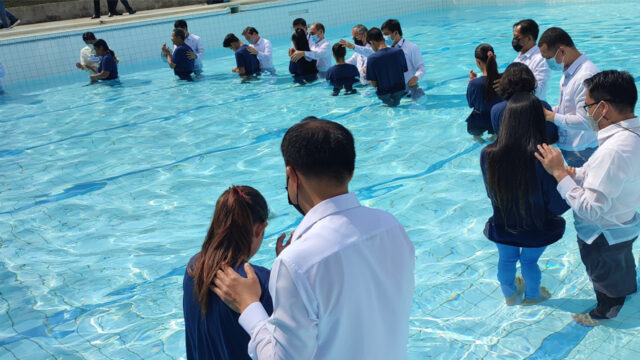A brief history of the Adventist missionary enterprise (1)

At the 1901 and 1903 General Conference sessions the Seventh-day Adventist Church underwent a dramatic reorganization to ensure it could reach out to all the world. Often when we tell the story of the early-twentieth-century reform of our church we tell it as chiefly a story of administrative restructuring. But I suggest that just as important, if not more so, was the mentality of the men elected as General Conference (GC) officers in 1901 and 1903.
Arthur Daniells served as president from 1901 to 1922; William Spicer served as GC secretary from 1903 to 1922 and then president until 1930. Both were visionaries of worldwide mission. Their joint passion, and that of the GC treasurers and vice presidents who served alongside them, and of the Secretariat team that Spicer gathered around him, was taking the Adventist message into unentered territories and to unreached peoples. As Spicer told the 1922 GC Session, which elected him president: “The cause of worldwide missions is not something in addition to the regular work of the church. . . . To carry the one message of salvation to all peoples . . . is the aim of every conference, every church, every believer.”
Thus, to restructuring was added the collective passion of General Conference leaders to expand the boundaries of mission; together these factors had a dramatic impact.
Going to All the World
From 1901 the number of new church workers dispatched from the homelands to the mission field gradually increased up to the start of World War I.
In 1909 and 1910 the number sent out exceeded 150—triple the number sent in 1901. The number of new mission appointees plateaued during World War I, but then spiked in 1920 at 310, twice the number 10 years earlier. In all, during the first 20 years after the 1901 reforms, the Seventh-day Adventist Church sent out 2,257 new missionaries. One result was global expansion. In 1920 the North American membership was 51.7 percent of the total, and the rest of the world’s share was 48.3 percent; the corresponding figures in 1921 were 49.83 and 50.17 percent. Thus, 1921 was the year that membership beyond North America finally exceeded that within the continent. That was undoubtedly largely because of the number of missionaries and the frontline, incarnational ministry that missionaries of that era performed.
While the figure of 300 new missionaries was not matched again until after World War II, throughout the 1920s the number of new missionaries each year was more than 150. The Great Depression caused a dramatic decline, with numbers falling below 100 per annum for three years—but then, for the rest of the 1930s, more than 100 new missionaries were sent out every year, despite the severe financial constraints the church faced. This number dropped again with the start of World War II, but even before the war ended it was climbing, thanks to remarkably bold and visionary planning by General Conference president J. Lamar McElhany and secretary Ernest D. Dick in the darkest moments of the war. It’s striking that even in the 15 years from the start of the Great Depression until the end of World War II, there were 1,597 new missionary appointees.
The quarter century following the war—1946–1970—was the golden age of the Adventist Church’s foreign missionary program: in these 25 years the number of “workers sent to mission fields” (which was the church’s official terminology) totaled 7,385.
In 1969–1970 new missionaries totaled 970—by far the largest number of new missionaries sent into service in any two-year period in the church’s history. But as the chart illustrates, it is no coincidence that 1969–1970 marked the high point of the missionary enterprise, for 1970 concluded a quarter century of mostly steady growth in missionary numbers. High numbers were sent abroad during 1945–1947, which were artificially inflated by the dispatch of large numbers of appointees who had been waiting for improvements in world conditions to travel, which in part led to the decline of 1948–1950, whose other cause was the collapse of the church in China. Then there were occasional peaks and troughs in the 1950s and 1960s—yet overall the trajectory was up, and after 1950, sustainably so. The second chart shows more than the annual numbers: it includes a fourth-order polynomial trendline, which reveals more clearly the steadily upward trajectory in this era.
Rising and Falling
The rise of Adventist mission in the 25 years after the end of World War II was the result of a huge, concerted team effort by church administrators, educators, medical leaders, and, of course, members in North America, Europe, Southern Africa, and Australasia. But leadership was important. The growth of the post-World War II years, like the dramatic expansion of the three decades after the 1901 reorganization, owed much to the commitment of the GC officers to mission. Reuben R. Figuhr, president from 1954 to 1966, and Robert H. Pierson, who succeeded him, had both served many years far from their American homeland as missionaries. Walter Beach, who served as GC secretary from 1954 to 1970, had also been a missionary, and he could not have been clearer at the 1964 Annual Council when he declared: “We are a world missionary church—not just a church with missions in all the world.”
Let’s go back to 1969 and 1970, however, which saw the highest and second-highest numbers of new appointees in our history: 473 and 470, respectively. These two years were the apogee. Since then the story quantitatively, if not qualitatively, has been one of decline.
In sum, during the 120 years since the 1901 reorganization, there was steady growth in the numbers of new appointees, checked only by the Great Depression and Second World War. This was followed by remarkable growth, which plateaued at the end of the 1960s. Since that point, the number of long-term missionaries being appointed has gone steadily and inexorably down.
Yet this has happened as membership is growing. The proportion of resources the church commits to worldwide mission, expressed as a proportion of the membership, has fallen more steeply and for longer than the decline in actual numbers of long-term missionaries. Furthermore, the nature of the work that missionaries do has changed as well; and they also are not as long-term as they used to be.
Incarnational Ministry
Here are just a few examples of missionaries and their service.
George D. Keough and his wife, Mary Ann, served as missionaries from Britain to the Middle East on three separate occasions. Starting in 1908, their service in the region totaled 33 years, with another four years spent at the General Conference, for a total of 37 years of missionary service. They began their third tour of duty when George was 65, an age others would be retiring; and they returned to their homeland only for the final time, when George was 72.
George and Laura Appel went to eastern Asia in 1920 and spent the next 38 years in mission service, 30 in China and elsewhere in eastern Asia, and eight in the Middle East.
Dick and Jo Hayden also spent 38 years as missionaries, starting in 1930, working in the mountains and jungles of Peru, Bolivia, and Ecuador.
Merritt and Wilma Warren served in China and the Philippines for 47 years, starting in 1913, and returned to their U.S. homeland (which must have no longer seemed like a home) only when Merritt was 69 and Wilma 72.
Ezra and Inez Longway spent 55 years as missionaries, starting in 1918: 30 years in the China Division and 25 in the Far East Division.
Keough, Appel, Warren, and Longway all served spells as union presidents, while Appel was Middle East Division president and Longway and Keough were division department directors. But all spent many years working first in frontline mission. For example, George Keough and his family spent most of their first 21 years as a missionary deep in the Egyptian hinterland, where George would go and sit on the earth floors of local people’s homes, eating whatever food they gave him, and winning them to Christ by representing Christ to them.2 In contrast, today’s missionaries tend to be based in institutions and administrative headquarters. Of course, there is a need for skilled medical practitioners, accountants, and IT professionals to serve the world church; but there is also still a need for people, today called from all around the world and sent all around the world, to represent Christ to people who do not know Him. It is GC Secretariat’s recognition of this fact that has led it to propose a Mission Refocus.
1 This article is largely based on A. L. Chism, D.J.B. Trim, and M. F. Younker, “We Aim at Nothing Less Than the Whole World”: The Seventh-day Adventist Church’s Missionary Enterprise and the General Conference Secretariat, 1863–2019 (Silver Spring, Md.: Office of Archives, Statistics, and Research, 2021), available from Amazon.
2 See D.J.B. Trim, “ ‘The Power of Real Christianity’: George and Mary Ann Keough’s ministry,” Adventist World, January 2021, pp. 24, 25.








